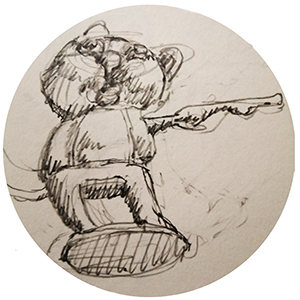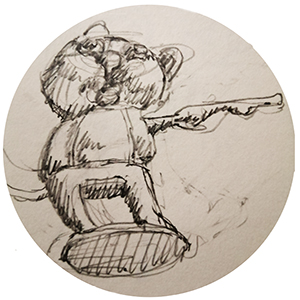Click here for sketchbook / maquettes / sources (under construction)
A Toy Theory of Drawing (for the exhibition Ordinary Things, curated by Prof. Louise Siddons, Winchester Gallery, November 2023)

Drawing is perhaps the most ‘ordinary’ material mode of cultural documentation, communication, and projection, in that it has been around longest – long predating writing (Ingold 2016), is globally ubiquitous, and is found at every level of graphic communication, from the art gallery to the diagram. Children draw before they speak or write.
These drawings presented in this little assemblage of Raspberry Pi and LED screen were made over nearly forty years, the first from my art foundation studies in Bradford, and are a mix of preparatory work for paintings and sculpture, sketches for the pleasure of drawing, and distracted doodles, the latter often filling the margins of notes at academic meetings. This year, as I finished writing a book on toys and technoculture, and sorted through dozens of sketchbooks and notebooks as I moved house, I was surprised at this persistent creative attention to the toy as a subject. The toy soldier images here are the most formally and conceptually intentional – a teenage anarcho-punk response on the one hand to the prevalence of the aggrandisement of male figures and historical themes in neo-expressionism (dominant in the art world in the mid-1980s), and on the other, but overlapping, my activism in the peace and anti-nuclear movement.
At the same time I began gathering small toys from slot machines and from Kinder Eggs. A sketchbook at the time muses on this revelation of sometimes surprising objects as an ‘archaeology of the present,’ or a ‘capitalist surrealism’ – and on reflection it has something of the spirit of Surrealism’s sideways grasp of the everyday, in its ethnographic aspects, its rummaging in the flea market, and its search for the marvellous in the mundane. A tiny plastic gun-toting cat was a particular fascination – as far as I can tell it refers to no existing character from cartoons or children’s literature. An all-American child with dungarees and baseball cap clutching a baseball bat, clicked together from pieces emptied from a Kinder egg capsule, carries a threatening charge. Two flat and flexible keyrings take the shape of wrestlers – from where, who knows? Much later, the sketchbooks document a distracted scribbling of parenthood and domesticity – the toys and play objects that happened to be on the floor or table in front of me when I felt the urge to draw.
Why this fascination with toys? It stems from a more general pleasure in drawing artefacts including sculpture, technical objects, ethnographic museum exhibits, and channels what in retrospect I see as a persistent attention to and communion with depiction, forming, and the simulacral through the act of drawing. On the other hand, this is often as much a convenient or practical subject as a conceptual one: toys are ordinary, small, always to-hand. In their cheapness, scale and multiplicity they offer a cornucopian and near random resource (or in the vending machine approach, fully random): objects for attention, easily carried and positioned, quickly drawn. The toy is generally (though not always) a miniature, a broad cultural form that, as Susan Stewart puts it, is a ‘world of things’ that ‘can open itself to reveal a secret life’ revealing ‘a set of actions and hence a narrativity and history outside the given field of perception’ – ‘the daydream of life inside life, of significance multiplied infinitely within significance’ (Stewart 1993:54).
Drawings, I think, generally have something of the toy about them. A drawing, unlike a painting, is often a plan, a testing of ideas, marks, composition and line – a play with form and materials. It makes the primal ‘what if?’ gambit of imaginative play: what if I sketched this object, or began to make marks and patterns – what images might emerge? And what could be made or built following these images? The architect’s drawing, or the sketch one might scribble when building some shelves, the schematic map on the back of an envelope – are all models, future-facing steps, a pointing in new directions, not depictions of a past event or state. Drawing has a ‘projective condition, always ancillary, anticipatory and pointing to a future outcome’ (Fay 2013), a ‘projected grasping’ as Derrida put it. Paintings (even abstract), like Bazin’s photographs, are mementos mori, depictions of a past event or idea, fixed in the layering of paint and effacing of brushstrokes. Whereas to look at a drawing is to follow its lines, hatching and shading as an activity or event in time, the act of drawing itself can be traced and followed across the paper. As Richard Serra notes, drawing is a verb. The drawings of young children in particular are generally of the here and now a temporal medium, a bringing into being and animation of characters and environments in the real-time of the act of drawing.
The drawing has its respectable place in art history and practice, but it is unstable, and it carries the potential to slip out of this valorisation. Until recently it hass been regarded mainly as a propaedeutic practice, a preparation for more prestigious, ‘completed’ works of painting and sculpture. And it always carries the potential to head away from official art into less respectable, and more playful, realms of graphic culture – from the grotesque fabulations in the margins of medieval manuscripts, to caricature, to games of automatism and exquisite corpse, the insolent graffiti of Duchamp’s L.H.O.O.Q., and from classical cinema to the animated cartoon. The ludic is never far away. Like children’s play with objects, drawing is a testing, a training, a rearranging and transforming of ideas, the phenomenal world, the materials and medium itself. To draw is to isolate and home in on, to identify a subject in the world or imagination, to manipulate it and render it worthy of attention through attention itself. It brings together eye, hand, materials, subject, environment, concepts, imagination in an event that renders all these components preternatural in their collusion and focused attention.
Brian Fay (2013) ‘A continuous incompleteness’, in What is Drawing? Dublin: IMMA Irish Museum of Modern Art.
Tim Ingold (2016) Lines: a brief history. London: Routledge.
Susan Stewart (1993) On Longing: narratives of the miniature, the gigantic, the souvenir. Baltimore MD: Johns Hopkins University Press.

Seth Giddings October 2023